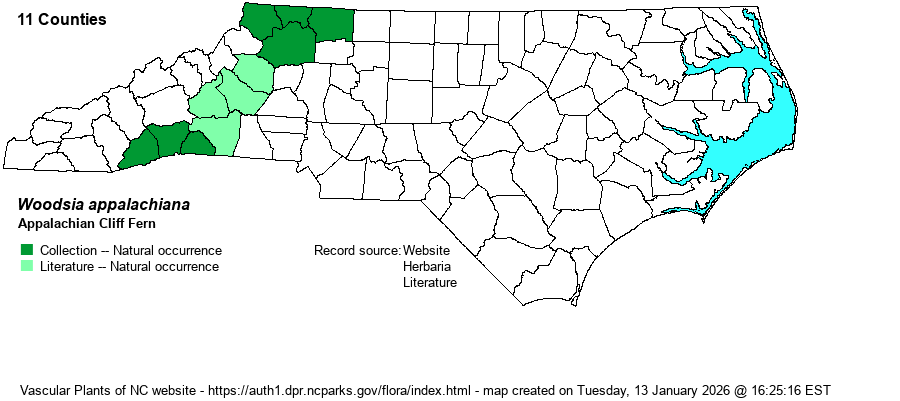| Section 2 » Order Polypodiales » Family Woodsiaceae |
Show/Hide Synonym
| taxonName | relationship | relatedTaxonName | relatedTaxonRefText | relComments |
|---|
|
|
|
|
|
| Woodsia appalachiana | < | Woodsia scopulina | Gleason and Cronquist (1991) | | | Woodsia appalachiana | < | Woodsia scopulina | Radford, Ahles, and Bell (1968) | | | Woodsia appalachiana | < | Woodsia scopulina | Small (1933, 1938) | | | Woodsia appalachiana | < | Woodsia scopulina | Wofford (1989) | | | Woodsia appalachiana | < | Woodsia scopulina | Flora of West Virginia | | | Woodsia appalachiana | = | Woodsia scopulina ssp. appalachiana | Flora of North America (1993b, 1997, 2000, 2002a, 2002b, 2003a, 2004b, 2005, 2006a, 2006b, 2006c, 2007a, 2009, 2010) | | | Woodsia appalachiana | = | Woodsia scopulina var. appalachiana | Gleason (1952) | | | Source: Weakley's Flora |
|
| Author | T.M.C. Taylor | |
| Distribution | Present in much of the Mountains, but mainly close to the Blue Ridge Escarpment, and thus at lower elevations, rarely over 3500 feet. Also ranges into the South Mountains in the western Piedmont.
This is a primarily Southern Appalachian species, ranging from northern WV south to western NC, northwestern GA, and disjunct in AR. | |
| Abundance | Rare in its NC range, though the NCNHP database contains 20 records, of which 15-17 are still extant. This is a Significantly Rare species. | |
| Habitat | This is a rock-inhabiting species, limited essentially to dry and mostly exposed cliffs and outcrops. Rock types are mainly felsic and often sedimentary, such as on sandstone, but also on granite, and various schists and gneisses. Thus, available habitats for the species are more widespread than for those limited to calcareous/mafic rock types. | |
| Phenology | Fruits from June to September. | |
| Identification | This is a lacy-cut fern of rocky sites, with a medium-sized frond. The stipe is brown, rather thick and hairy, about 2-3 inches long. The blade is rather lanceolate to narrowly ovate, narrower toward the apex but somewhat narrowed at the base, and is bipinnately cut; the blade averages 8 inches long and about 2 inches wide. There are 9-20 pairs of pinnae, sub-opposite, typically no more than 1 inch long, and each pinna has 7-10 pairs of pinnules. The sori are in indusia, near the margins of the pinnules. Separation of the three Woodsia species, as well as the several Cystopteris species, can be quite difficult without a hand lens. Woodsia species have "the indusium divided into a series of scale-like or hair-like structures, attached below the sorus; Cystopteris has an undivided indusium, pocket-like or hood-like, attached around one side of the sorus. Woodsia has persistent dark petiole bases; in Cystopteris the petiole bases are deciduous. Woodsia has the final veinlets not reaching the margins; Cystopteris veins do reach the margin." (Weakley 2018). Within Woodsia, this species can be separated from the more widespread W. obtusa by having "Pinnae with numerous long whitish scales", versus W. obtusa having "Pinnae without scales, a few broad scales on the midrib" (Wofford 1989). W. ilvensis has the petioles "with a distinct joint about 1-3 cm above the base" (Weakley 2018), such that former blades leave a rather even stubble, as opposed to the other two that lack such a joint, and the former leaves having an uneven stubble of broken stipes. | |
| Taxonomic Comments | This species was formerly named as W. scopulina. Weakley (2018) mentions that W. appalachiana is the Eastern population that has been split off from that now Western species.
| |
| Other Common Name(s) | Appalachian Woodsia, Mountain Woodsia | |
| State Rank | S2 | |
| Global Rank | G4 | |
| State Status | SR-P | |
| US Status | | |
| USACE-agcp | | |
| USACE-emp | | |

